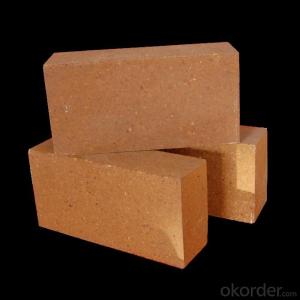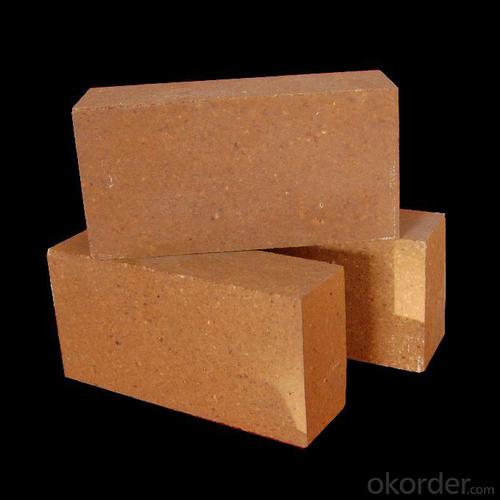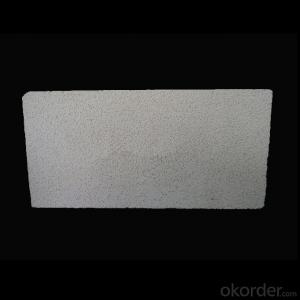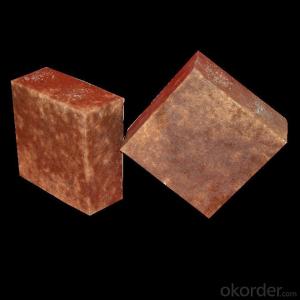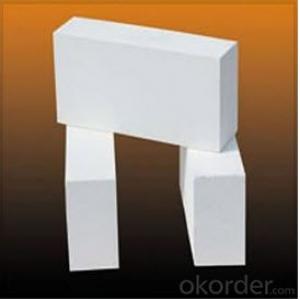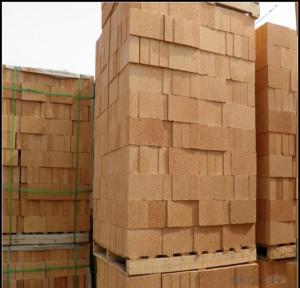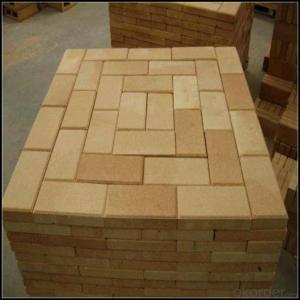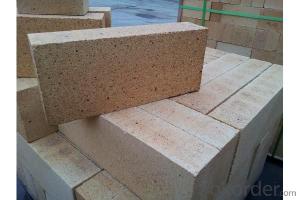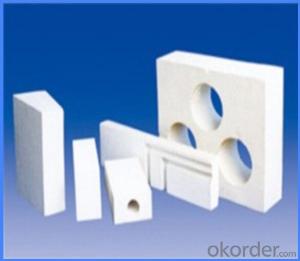Insulating Fire Brick for Steel/Cement/Glass Making Furnaces/Kilns
- Loading Port:
- Shanghai
- Payment Terms:
- TT OR LC
- Min Order Qty:
- 10 m.t.
- Supply Capability:
- 100 m.t./month
OKorder Service Pledge
OKorder Financial Service
You Might Also Like
Quick Details
| Place of Origin: | (Mainland) | Shape: | Brick | Material: | Alumina Block |
| SiO2 Content (%): | - | Al2O3 Content (%): | 42-75 | MgO Content (%): | - |
| CaO Content (%): | - | Refractoriness (Degree): | Common (1580°< Refractoriness< 1770°) | CrO Content (%): | 0 |
| SiC Content (%): | 0 | Model Number: | NG/LG/LZ | Brand Name: | |
| Sample: | Free | Name: | refractory brick | Bulk density: | 0.5-2.8 |
| Refractoriness: | 1150-1790 °C | RUI: | 1250-1520 °C | Apparent porosity: | ≤28 |
| CCS: | 1.5-54MPa | Fe2O3 Content (%): | ≤1.00/1.20/1.65/1.80 |
Packaging & Delivery
| Packaging Detail: | Fumigated wooden pallet, using paper or non-woven fabrics between layers separated, plastic shrink film protected outside, then the straps. Finally make the wooden pallet (95*95cm, 95*100cm) or as your requirements. |
| Delivery Detail: | 20 working days after deposit received. (based on real quantity) |
Specifications
All kinds of refractory brick for different industrial furnaces
28 year old manufacturer
ISO, TUV, SGS certificate
low prices
As a 28-year-old refractory material manufacturer, we have worked with many steel plants, metallurgic plants, cement plants, glass plants, provided them with top notch products and services. Here are the refractory bricks we produce:
| Brick Name | Application |
Clay brick | Normally used in the permanent layer of industrial kilns and furnaces, sometimes used in working layer. |
| Clay insulating brick | Normally used in the insulating layer of industrial kilns and furnaces. |
| High alumina brick | Mainly used in the working layer of blast furnace, airheater, EAF roof, reverberatory furnace, rotary kiln, etc.. It is also used as checker brick in regenerative chamber of open-hearth furnace, plug at gating system, shroud, etc.. |
| High alumina insulating brick | Normally used in the insulating layer of industrial kilns and furnaces. |
| High alumina EPS insulating brick | Normally used in the insulating layer of industrial kilns and furnaces. With higher strength than clay/high alumina insulating bricks. |
| Magnesia carbon brick | Used in working layer of ladle, refining ladle, converter, electric arc furnace, etc.. |
| Alumina-magnesite carbon brick | Used in working layer of ladle, pig iron ladle, electric arc furnace, etc.. |
| Magnesia-calcium brick | Used in working layer of electric arc furnace, refining furnace like AOD, VOD furnaces, etc.. |
| Magnesite-chrome brick | Used at high temperature zone and firing zone of rotary cement kiln. |
| Magnesia brick | Used in permanent layer of converter, AOD furnace, etc.. |
| AZS brick | Normally used at glass melting furnace hearth. |
| Silica brick | Partition wall of carbonization chamber and firing chamber of cock oven; Regenerative chamber and slag pocket of steelmaking open hearth furnace; Soaking pit furnace; Glass melting furnace; Weight bearing areas such as vault of the calcining kilns of refractory silica brick and ceramic; Weight bearing area of airheater; Roof of acid open hearth furnace. |
| Checker brick | Regenerative chamber of blast furnace hot blast stove, flame furnace. |
| Anchor brick | Normally used to strengthen refractory layers of industrial furnace or flue, or is used when the furnace body structure is too thick or overload or the temperature at working area is too high. |
| Baffle brick | Mainly used in regenerative chamber of heating furnace. |
| Purging plug | Blowing gas into the molten steel through it. |
| Purging plug seat block | Purging plug seat block |
| Low carbon brick | Normally used in the working layer of refining ladle, producing high class steel. |
| Carbon free brick | Normally used in the working layer of refining ladle, producing high class steel. |
| Alumina magnesia spinel brick | Mostly used at transitional area of rotary kiln. |
| Corundum brick | Widely used in many kinds of furnaces or kilns. |
| Al-SiC-C brick | Widely used in the working layer of blast furnace, foundry ladle, metal mixer, molten steel trough, etc.. |
If you are looking for solutions for steel making, cement making, alloy steel making, glass making, etc., please do not hesitate to contact us, we can help you with our products and experience
- Q: Do insulating fire bricks have a high fireproof rating?
- Yes, insulating fire bricks have a high fireproof rating. They are designed to withstand high temperatures and provide excellent insulation, making them ideal for applications where fire resistance is necessary.
- Q: Are insulating fire bricks suitable for insulation in heat treatment furnaces?
- Yes, insulating fire bricks are suitable for insulation in heat treatment furnaces. Insulating fire bricks are designed to withstand high temperatures and provide excellent thermal insulation, making them ideal for use in heat treatment furnaces where maintaining consistent and controlled temperatures is crucial. These bricks help minimize heat loss, increase energy efficiency, and ensure uniform heating throughout the furnace, resulting in improved performance and cost savings.
- Q: Can insulating fire bricks be used in foundries?
- Yes, insulating fire bricks can be used in foundries. They are commonly used as lining materials for various high-temperature applications, including foundries. Insulating fire bricks provide excellent thermal insulation, reducing heat loss and improving energy efficiency in the foundry process. Additionally, they have good resistance to thermal shock and can withstand the extreme temperatures and harsh conditions often found in foundry environments.
- Q: Can insulating fire bricks be used as a heat shield?
- Yes, insulating fire bricks can be used as a heat shield. Insulating fire bricks are designed to have excellent thermal insulation properties, which means that they can effectively block and reflect heat. They are commonly used in applications where heat needs to be contained or redirected, such as in fireplaces, kilns, furnaces, and industrial ovens. The insulating properties of these bricks allow them to reduce heat transfer, providing a barrier between the intense heat source and the surrounding environment. Additionally, they have high melting points and can withstand high temperatures, making them suitable for use as a heat shield. However, it is important to note that the effectiveness of insulating fire bricks as a heat shield may vary depending on the specific requirements and conditions of the application.
- Q: Are insulating fire bricks resistant to sound transmission?
- Insulating fire bricks, also known as refractory bricks, are primarily designed to withstand high temperatures and provide thermal insulation. While they are effective in reducing heat transfer, they are not specifically designed to resist sound transmission. Insulating fire bricks are made from materials such as clay, alumina, and silica, which are chosen for their ability to withstand high temperatures. These materials are dense and have a low porosity, which helps to prevent heat from passing through the bricks. However, sound waves can easily pass through solid materials, including insulating fire bricks, unless additional measures are taken to reduce sound transmission. To effectively reduce sound transmission, other soundproofing methods should be used in conjunction with insulating fire bricks. These can include adding additional layers of acoustic insulation or using sound barriers such as mass-loaded vinyl or acoustic panels. In summary, while insulating fire bricks are excellent for thermal insulation, they are not inherently resistant to sound transmission. Additional soundproofing measures should be taken to effectively reduce noise transmission in a given space.
- Q: Are insulating fire bricks resistant to molten metals?
- Yes, insulating fire bricks are generally resistant to molten metals. Insulating fire bricks are made from refractory materials that have high melting points and excellent thermal insulation properties. This makes them suitable for applications where they come into contact with high temperatures, including molten metals. The insulating properties of these bricks help to minimize heat transfer, preventing the heat from the molten metal from being conducted through the brick. Additionally, the refractory materials used in these bricks have low thermal expansion, which allows them to withstand thermal shock that can occur when molten metals come into contact with the bricks. However, it is important to note that the specific resistance of insulating fire bricks to molten metals can depend on factors such as the type of metal, temperature, and duration of exposure. Therefore, it is recommended to consult with the manufacturer or a professional to ensure that the insulating fire bricks are suitable for the specific application involving molten metals.
- Q: How do insulating fire bricks help improve the efficiency of combustion processes?
- Insulating fire bricks play a pivotal role in enhancing the efficiency of combustion processes through various means. To begin with, their insulating properties aid in minimizing heat loss and sustaining higher temperatures within the combustion chamber. This is of great significance as elevated temperatures promote more thorough combustion, resulting in reduced fuel consumption and heightened energy efficiency. By impeding heat dissipation, insulating fire bricks also contribute to the preservation of thermal energy within the combustion system. Consequently, less heat is wasted, and a greater portion of it is utilized for the combustion process, ultimately leading to an overall improvement in efficiency. Furthermore, insulating fire bricks can assist in establishing a more controlled and stable combustion environment. They serve as a thermal barrier between the combustion chamber and the surrounding surroundings, mitigating the risk of heat transfer to external components and minimizing the likelihood of overheating or damage to the combustion system. Moreover, insulating fire bricks can aid in the reduction of emissions during combustion processes. By sustaining higher temperatures, they encourage more complete combustion, consequently resulting in lower levels of harmful pollutants being released into the atmosphere. This is particularly critical for industries that must adhere strictly to environmental regulations. In conclusion, insulating fire bricks enhance the efficiency of combustion processes by minimizing heat loss, preserving thermal energy, establishing a controlled environment, and reducing emissions. Their capacity to sustain higher temperatures and prevent heat transfer ultimately leads to reduced fuel consumption and improved energy efficiency.
- Q: How do insulating fire bricks affect the overall durability of a structure?
- The overall durability of a structure is significantly improved with the inclusion of insulating fire bricks. These bricks are designed with a low thermal conductivity, effectively resisting heat transfer. By limiting the amount of heat that passes through, they maintain a stable temperature within the structure, safeguarding it against extreme temperature changes. One of the primary advantages of insulating fire bricks is their capacity to endure high temperatures. They possess a high melting point, enabling them to maintain their structural integrity even in the presence of intense heat. This characteristic is particularly important in structures that generate high temperatures, such as furnaces or kilns. The ability of insulating fire bricks to withstand such extreme heat greatly contributes to the structure's durability. Additionally, insulating fire bricks offer exceptional insulation. Their low thermal conductivity prevents heat from escaping or entering the structure, resulting in energy efficiency. This not only reduces energy consumption, but also shields the structure from potential damage caused by excessive heat loss. By maintaining a consistent temperature, insulating fire bricks prevent thermal expansion and contraction, which can lead to cracks and structural instability. Apart from their resistance to heat and insulation properties, insulating fire bricks are also known for their resistance to chemical corrosion. Many structures are exposed to harsh environments or chemicals that can cause deterioration. However, insulating fire bricks are made from materials that resist chemical reactions, ensuring their durability and longevity. Overall, the utilization of insulating fire bricks significantly enhances the durability of a structure. Their capacity to endure high temperatures, provide insulation, and resist chemical corrosion makes them a valuable component in various industrial and residential applications. By ensuring a stable and protected environment, insulating fire bricks contribute to the long-lasting and reliable performance of the structure.
- Q: Are insulating fire bricks suitable for commercial or industrial applications?
- Yes, insulating fire bricks are suitable for commercial and industrial applications. They are commonly used in high-temperature environments such as furnaces, kilns, and ovens, where they provide excellent insulation and heat resistance. Their ability to withstand extreme temperatures and thermal shock makes them ideal for commercial and industrial settings where heat containment and energy efficiency are crucial.
- Q: Can insulating fire bricks be recycled or reused?
- Insulating fire bricks have the potential to be recycled or reused. These bricks are composed of various materials like alumina, silica, and clay, which can be broken down and utilized in the production of fresh bricks. Recycling involves crushing the bricks into a fine powder and combining it with other raw materials to form new bricks. Additionally, reusing insulating fire bricks is viable in specific applications. If the bricks are still in good condition and undamaged, they can be extracted from one structure and employed in another. This practice decreases waste and conserves resources. In summary, whether through recycling or reusing, insulating fire bricks possess the ability to have a secondary life, contributing to a more sustainable and environmentally-friendly construction industry.
Send your message to us
Insulating Fire Brick for Steel/Cement/Glass Making Furnaces/Kilns
- Loading Port:
- Shanghai
- Payment Terms:
- TT OR LC
- Min Order Qty:
- 10 m.t.
- Supply Capability:
- 100 m.t./month
OKorder Service Pledge
OKorder Financial Service
Similar products
Hot products
Hot Searches
Related keywords
